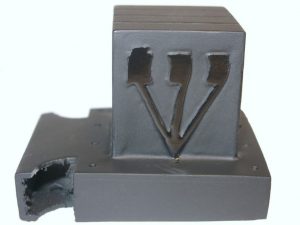On My Mind – A Weekly Letter from Rabbi Davis – January 10, 2020
Shalom Chaverim
The process of making tefillin is complicated and detailed. One of the first steps in the process that fascinates me is making the letter shin on the head tefillin. The leather is embossed with a special press. 
Why do we put a shin on the tefillin? Some explain that its gematria, 300, represents the number of days a year tefillin are worn. But there is more. The shin, like the shin on a mezuzah, stands for Shaddai. One of the oldest names used for God in the Bible, it is usually translated “God Almighty.” But the truth is, we don’t know exactly what the word means. Even the earliest translations of the Torah into Greek, Latin, Syriac, etc. do not have uniform renderings.
Not surprisingly, therefore, the midrash offers its own definition. Shaddai stands for “God who said Dai (enough)!” The explanation appears where God spoke to Abraham saying, “I am El Shaddai. Walk in my ways and be blameless.” In other words, God is saying, “Enough is enough. The people of the world are acting deplorably. It is high time to demand righteous behavior of them.”
In addition to the embossed shin on the head tefillin, we wrap the tefillin on our hand in such a way so as to spell out Shaddai. Taken together with the midrash’s understanding of the name, the message is clear: Both our thoughts and our actions are to be blameless. We are to be people of integrity striving for righteousness, purifying our mind and sanctifying our deeds.
Given events of the past week, I can’t help but think about the shin as representing Shalom. Its very shape speaks to this notion. The Maharal of Prague teaches that the shin’s three heads symbolize two opponents standing on the extreme sides of a controversy and the Divine mediator in the middle.
As the maker of harmony, one of God’s name is “Peace.” The implication is clear, “For man to thrive spiritually he must copy the attributes of his Maker. This is especially the case with regard to peace, since it is essential for man’s survival that he harmonize the diverse elements of the world” (Rabbi Michael Munk, The Wisdom in the Hebrew Alphabet.) The tefillin thus remind us to make peace top of mind and put our hands to work to make our vision a reality.
Bivrakha,
Rabbi Alexander Davis
adavis@bethelsynagogue.org
Beginning this Sunday, we are delighted to welcome artist-in-resident, Noah Greenberg, from Sfat, Israel who will lead a program making tefillin with dozens of participants. This is a unique and fascinating experience brought to Beth El by The Well. I invite you to stop by the Learning Center Sunday morning, Tuesday or Thursday early evening to see for yourself.
